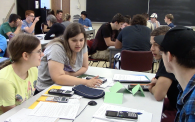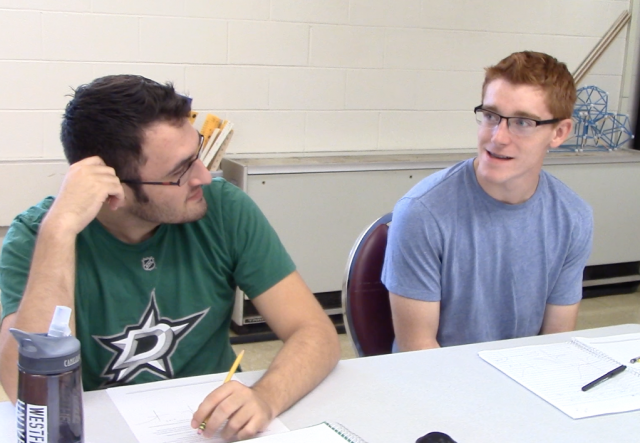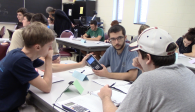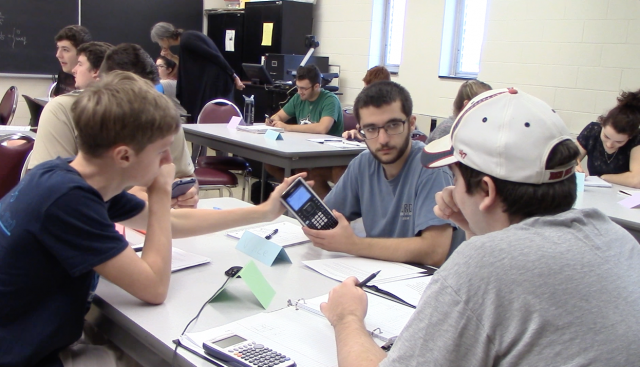An Aspiring Teacher Learns about Inquiry by Videotaping a Semester of Calculus
Written by: Dr. Christine von Renesse.
In this blog, guest writer and aspiring teacher Lauryn Zaimes describes her insights into the intricacies of teaching with inquiry gained while videotaping a semester of Calculus. I hope that reading her experience will motivate practitioners like you to ask students to video tape your class sometime. While Lauryn clearly learned a lot from her experience, I learned at least as much! First of all, I was able to deeply reflect on my own teaching by watching the video clips (once I got over the way I look and talk...). Additionally, I could observe students doing mathematics at times when I was not actually sitting with them and learned a lot about their thinking and motivation. I also talked with Lauryn before and after every class about her observations and what she would do next. Through our conversations I had a co-teacher and partner in crime that I am often missing when I am teaching.
A Look From the Outside
By Lauryn Zaimes
Background
For the Fall 2016 semester, I had the opportunity to videotape and occasionally co-teach in Professor von Renesse’s Calculus I course. For a bit of background, I had taken Calculus I-III with Professor von Renesse, and she commences her practice solely in an inquiry-based setting. I personally remember being in her Calculus I as a freshman and being introduced to this style of teaching for the first time. Initially, it was overwhelming to hear that there was going to be no lecturing throughout the course. It was disconcerting; for lectures were the only style of teaching I had ever been exposed to, especially in a mathematics course. However, after working diligently through the course, I could not imagine learning Calculus in any other way. Therefore, I jumped at the opportunity to go back and work as an outsider in the same classroom to see other students struggle and succeed in the same ways that I had done previously.
Due to working with the class every day, I became well versed in the little nuances of the class and observed each student's different needs and mathematical aptitudes. With this, I gained a deeper knowledge on how an inquiry-based classroom works efficiently, while also learning how to address issues to assure that everyone works on pace.
Grouping the Calculus 1 Class:
The core of any classroom is the student body, and this Calculus class had quite the range of students, as there are in all classes. There are always the students who are naturally skilled and see patterns and reasoning quickly, meanwhile there are also students who are a bit slower and need to work harder to come to the same conjectures. Lastly, there are the students who fluctuate between these extremes, for they may be strong in some areas, yet weaker in others. A hard dance that a lot of professors have to follow is how to group these different types of students efficiently so that everyone is working at the highest caliber, and a downside to this is that it can be a long process. Professor von Renesse, as I can recall from my experiences as well, begins every semester by using nametags and initially randomly generating groups until she gets a feel for how students operate. Looking from her vantage point this time around, I saw how difficult the grouping process could be once you gauge the skills and attitudes of each student, for there exists an endless amount of combinations of groups, and narrowing that down to a handful of groups that all work cohesively is cumbersome. For example, there was a particular student, referred to as Student A, who did not work well with a lot of students, and it took some time to find a group that she would work best with. Once we found a student that she worked well with, it was decided that placing another student into that pairing would distract Student A and would lead her to getting side-tracked very easily. This discovery took a few weeks to unfold, but once it was found, the final grouping worked efficiently.
Another discovery that I made when observing the grouping process was that groups that you initially believe will work well may not pan out the way you had hoped. Conversely, some groupings that you predicted would not mesh well may surprise you due to how well they actually work. For example, grouping all the higher-level thinkers may intuitively sound brilliant because these intelligent minds can hypothetically get together and bounce ideas off each other and share deep academic discourse. However, from what I saw in this class, when brightest students were grouped together, not a word was spoken throughout the class. If something was said, it potentially angered another group member if they did not agree. At the same time, however, when two quieter, slower students were grouped with a quicker, outspoken student, the group worked flawlessly.
Overall, what I took away from this part of the experience was that grouping students efficiently is a more of a science that needs to be mastered, for students cannot be carelessly thrown together. With each group, there needs to be a dynamic established that is conducive to optimal learning for each student. This attests to why some groups unexpectedly work well together, just as in the case mentioned earlier with the two quieter students being paired with a more outspoken student. Also, no matter how skilled you are at assessing student abilities, it still takes time to group the students perfectly. However, the benefits of developing the perfect groups are worth the wait.
Staying Flexible...
Now, even after a teacher has found the perfect groupings, there are a few mishaps that may still occur throughout the class. In the specific case of this course, if the groups did not mesh well, or even if they were just having an off day, it led to little academic discourse within the groups, which further trickled into the whole-class discussions being very dry and brief. Inquiry-based learning is very dependent on enthusiastic academic discourse, and whole-class discussions are implemented to summarize key points or to share out conjectures about a certain problem raised by the professor.
It can be hard to overcome these lulls of silence, but there are several strategies that a teacher can implement that attend to this issue. If a teacher ever finds that the students are too quiet, asking them thought-provoking extension questions can spark a discussion that can drive student curiosity. For example, if a group is quiet and stuck on a question, the professor can ask, “can you draw me a picture to represent this?” This allows students to be creative and think of a way to represent their work in a different way, which will lead to the quiet group to start bouncing ideas off one another. Another strategy that motivates a single group is asking a student to explain a piece of work, and then following up by having another student revoice what the previous student has said. This suggestion forces students to explain their findings in their own words, and if any of the students do not fully understand the mathematics at hand, then they must work through it together so everyone is on the same page. A third suggestion truly sparks curiosity, and it is when the professor compares two different conjectures and has the class discuss which one is right and which one is wrong, which creates a debate-like atmosphere. This was done several times throughout the Calculus class, and it made the student more engaged and passionate about the work, for they had to review their own work and discuss comparisons to the other conjecture. Overall, while the students are constantly prompted to be involved, it is up to the teacher to keep thinking as well, for they must always be ready to ask thought-provoking questions to maintain momentum in the classroom.
Students helping Students
Now, one of the most beneficial aspects of implementing an inquiry-based classroom in my experience is that the teacher can utilize the students as a resource for helping guide their peers through a difficult lesson, which is not often achieved in lecture-based classes. In a specific case during Calculus I, there was a class period where two students, referred to as Student A and Student B, were working together on derivatives. Student A was well versed in derivatives and Student B was struggling and getting very frustrated with her work. However, due to the collaborative setting of the classroom, A worked with B slowly and calmed her down by creating her own, simpler examples for B to work through. During these smaller examples, A talked B through the work step-by-step and asked her prompting questions. With this, B became much more confident in her abilities and calmly derived the original questions that she had struggled with beforehand. As an aspiring teacher, this was a beautiful moment to capture on camera because it is not something seen in most classes. If this were a class where students did not often collaborate with each other and commonly shared ideas, this discourse and mini-tutoring session would not have taken place. However, due to the nature of this course, it was natural for Student A to behave in such a way. You can see an excerpt of the described moment in the following video clip:
Conclusion:
As the semester came to a close, I saw a genuine change in the students. While they were still shy, they we more apt to discussing complex problems in context and were more confident when presenting a new conjecture. They also became less afraid of disagreeing with someone, for this can be daunting for students who are not used to this atmosphere. As an aspiring teacher who wants to implement inquiry-based learning in my own classroom, it is my goal to see these aforementioned changes in my own students. Watching these developments firsthand in a classroom that I worked so closely with convinces me that this style of teaching contributes to achieving these goals due to the implementation of, first, properly formed groups, and second, strategies that stimulate the curiosities of the students and create vivid discussions. In all, I am beyond ecstatic that I was given this opportunity so I could hone in on what it takes to successfully run an inquiry-based classroom and see what successes and hardships come with taking on this type of instruction.







